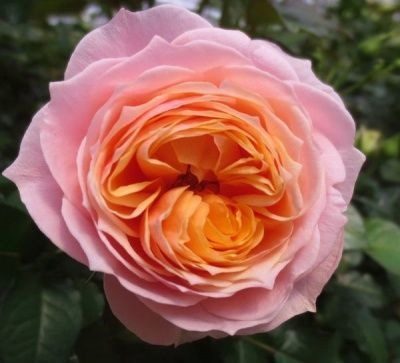
- Authors: De Ruiter
- Name synonyms: Vuvuzela
- Breeding year: 2011
- Group: tea-hybrid
- The main color of the flower: orange, pink
- Flower shape: peony
- Flower size: large
- Diameter, cm: 9-10
- Flower type by number of petals: thick double
- Description of the bush: quite compact
The Vuvuzela rose variety was bred by a Dutch company called De Ruiter in 2011. This variety came to Russia later, but it still quickly gained popularity among local gardeners.
Description of the variety
Vuvuzela, also known as Vuvuzela, belongs to the scrub and hybrid tea class and is intended for climates with colder winter temperatures down to –23 degrees. A fairly compact bush in height does not exceed 1.1 meters, and in diameter is about 60 centimeters. The shoots are covered with olive-green leaf blades in moderation. The powerful and branching root system goes deep into the ground by 60 centimeters. On each stem, usually from 1 to 3 flowers are tied, the diameter of which is 10 centimeters.
The bud is characterized by a peony shape and dense, densely double petals in the amount of 38-45 pieces. Of particular interest is the color of the flowers, which can range from sandy or orange to coral, peach and golden. They reach 9-10 centimeters in diameter and do not form inflorescences, being located one by one on the stem. The aroma of Vuvuzela roses is quite pleasant, but very light and almost imperceptible.
Advantages and disadvantages
The Vuvuzela rose variety has many advantages. They have strong immunity that protects against the most common diseases - powdery mildew and black spot, and pests, and also tolerate winter cold snaps well in most regions. Plants grow quickly and delight their owners with lush flowering. The plus is that the culture does not require particularly complex care. The disadvantages of the variety include its almost indistinguishable smell, although in the case of allergy sufferers, this, on the contrary, is a plus. It should also be mentioned that after the rain, the flowers become covered with small specks, and from the excess of fertilizer, the leaf blades turn yellow and fall off.
Flowering features
The very abundant flowering of Vuvuzela roses occurs twice a season, with the first wave beginning in mid-spring, and the second ending in late autumn. However, you cannot call it particularly magnificent, since each time it lasts about 10 days.
Landing
Vuvuzela roses are planted in early spring. A well-lit and sufficiently ventilated place with loamy and humus soil, characterized by weak acidity, is chosen for the culture. The soil on which the plant will be located must be nutritious and contain a sufficient amount of minerals. Damp, heavy and clayey soil will need to be normalized by adding humus, peat or compost. Excessive acidity is neutralized with slaked lime or chalk. Stony or sandy soils are absolutely not suitable for Vuvuzela, as they will overheat in the heat and will not be able to retain moisture.
For flower seedlings, you will need to dig holes about 70 centimeters deep and 60-100 centimeters in diameter. Before immersion, the roots are recommended to be treated with a growth stimulant. When planting, the root collar must be located at ground level. At the bottom of the hole, a layer of fertilizers and compost is necessarily formed.Placing several copies on the site, it is necessary to maintain a gap of 0.5 meters between them. The recommended planting pattern is triangular. Immediately after planting, the beds are mulched with humus.
It should be added that the most popular way to propagate the Vuvuzela rose is by cuttings. Only freshly cut material that has not been treated with chemicals and has at least three buds is subject to use. A fragment of the stem is cut obliquely with a sharp instrument at a distance of 3 centimeters from the bud. Before use, the branch is cleared of thorns and freed from buds.
Growing and care
Vuvuzela rose bushes have to be watered as the root zone dries up. It is best to do this late in the evening. It is recommended to fertilize the crop with horse manure, which does not have the ability to draw nitrogen from the soil. It is customary to scatter the substance near the bushes, forming a layer 2 centimeters thick. When the rose begins to form buds, it needs mineral complexes containing potassium and phosphorus. It should be mentioned that in June, the culture necessarily requires nitrogen, and at the end of August, any feeding should be stopped. If the plant receives an excess of fertilizer, then its foliage will turn yellow and fall off.
Pruning the rose bush is an important care procedure. It is customary for a plant to cut off aged and weakened shoots, as well as pinch off excess buds. As part of spring formation, a third of unnecessary branches are usually removed. At the end of the active season, that is, in mid-October, faded buds are removed from the bush and all ripe shoots are cut off. Finally, before winter, plantings are covered with dry foliage, sawdust or straw. A mixture of garden soil, peat and humus is also suitable for this purpose, but the film and polyethylene should not be used categorically, otherwise Vuvuzela will die from a lack of oxygen.































































